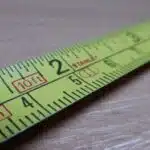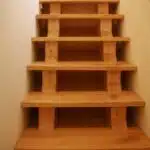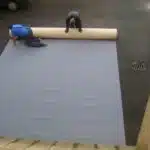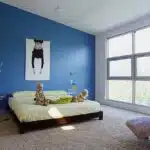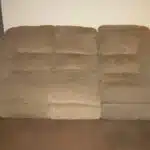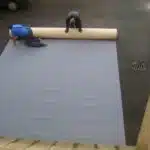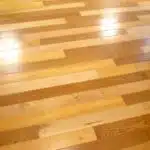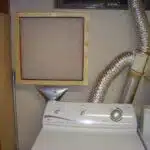As a carpet measurement expert, I understand the importance of accurately measuring how much carpet you need for your space. Whether you are renovating a room or starting from scratch, knowing the correct amount of carpet to purchase can save you time, money, and frustration. In this article, I will guide you through the basics of measuring how much carpet you need and provide tips to ensure your measurements are accurate.
Before purchasing any type of flooring material, it is essential to measure the space accurately. Measuring for carpet is not as straightforward as measuring for other types of flooring materials because carpets come in various lengths and widths. Additionally, rooms are not always square or rectangular in shape, which adds complexity to the measurement process. Accurate measurements are critical since buying too little or too much carpet can lead to unnecessary expenses and delays. By following simple steps and using easy-to-use tools like a measuring tape, you can measure your space accurately and efficiently.
Tools Needed For Measuring Carpet
Accurately measuring carpet is a crucial step in any home renovation or remodeling project. While measuring carpet without tools may seem like an easy task, it can lead to inaccurate measurements and wasted time and money. Therefore, having the right tools is essential to ensure precise measurements.
The most basic tool you will need for measuring carpet is a tape measure. It is recommended to use a 25-foot tape measure with a locking mechanism to prevent it from retracting while taking measurements. A straightedge or ruler can also be helpful in ensuring that your measurements are straight and accurate. Additionally, having a notepad and pen handy can help you keep track of your measurements as you go along.
Tips for accurate carpet measurements include determining the direction of the carpet pile, which will affect how much excess material needs to be added for proper installation. It is also important to measure every area of the room where the carpet will be installed, including closets and alcoves. To ensure accuracy, take measurements multiple times and double-check any areas that may require special attention.
In preparing the room for measurement, it is important to remove all furniture and other objects from the space. This will allow you to take accurate measurements without any obstructions or barriers. Once the room has been cleared, use your tape measure and other tools to take precise measurements of each area where carpet will be installed.
Preparing The Room For Measurement
Before measuring the carpet, it is important to prepare the room for accuracy. This includes clearing furniture out of the way and creating an open space for measurements. It is recommended to move all furniture from the room being measured to another location temporarily. This will allow you to take precise measurements without any obstacles in your way.
Next, take note of the room layout. It’s important to measure not just straight walls, but also any angles or irregularities in the room. Be sure to measure every area that needs carpeting including closets and hallways. By taking these extra steps, you can ensure that you have enough carpet for your entire space.
Finally, consider measuring doorways and windows in addition to the dimensions of your floor space. Knowing these measurements will help you determine how much carpet you need while minimizing waste. If you choose a patterned carpet, having these measurements can help you plan how the pattern will be oriented in each room.
Markdown List:
- Move all furniture out of the room before measuring
- Take note of any irregularities in the room layout
- Measure all areas that need carpeting including closets and hallways
- Measure doorways and windows to minimize waste
With a clear understanding of how to prepare your space, it’s time to move on to measuring square footage accurately.
Measuring Square Footage
After preparing the room for measurement, the next step is to determine how much carpet you need. This process involves measuring the square footage of the room and taking into account the thickness of your chosen carpet. Measuring carpet thickness is essential because it affects how much material you will need to cover the floor.
To measure square footage accurately, divide the room into smaller sections and measure each section individually. Use a tape measure to record the length and width of each area in feet before multiplying these numbers together. Once you have measurements for all sections, add them together to get the total square footage. However, even with careful calculations, mistakes can happen.
Common mistakes when measuring carpet include forgetting to factor in areas that are hidden from view or not accounting for irregularities in room shape. These errors can result in purchasing too little or too much material, leading to added expenses or wastage. It is crucial to ensure accuracy during this process as it directly impacts how well your new carpet will fit in your space.
Remember that every detail counts when measuring carpet, from determining its thickness to avoiding common errors during calculations. Taking time to follow proper procedures will help ensure that you buy only what is necessary and avoid costly mistakes down the line. Next up, we’ll discuss how to measure irregularly shaped rooms effectively without sacrificing accuracy or ease of measurement.
Measuring Irregularly Shaped Rooms
It’s always a treat to be faced with the challenge of measuring an irregularly shaped room. As a carpet measurement expert, I relish in the opportunity to flex my mathematical muscles and come up with creative solutions for maximizing coverage. One of the biggest hurdles when dealing with irregular shapes is determining how much excess material you’ll need to account for.
When it comes to measuring rooms with angled walls or unusual layouts, precision is key. You’ll want to measure each dimension multiple times to ensure accuracy and account for any discrepancies caused by angles or curves. This may seem tedious, but taking the time to accurately measure your space will save you from costly mistakes down the line.
Maximizing coverage in an irregularly shaped room can be achieved by strategically placing seams and cuts in areas that won’t be as noticeable, such as under furniture or along baseboards. It’s important to keep in mind that not all carpets are created equal and some patterns may require extra material for matching up correctly. By taking these factors into consideration, you can ensure that your carpet installation looks seamless and professional.
When dealing with irregularly shaped rooms, it’s crucial to take note of nooks and crannies that may require additional material. These areas can include closets, alcoves, or even window sills. By factoring in these small details during the measuring process, you can avoid running short on material or having awkward gaps in your installation. Remember, every inch counts when it comes to achieving a flawless finish!
Taking Note Of Nooks And Crannies
Having measured an irregularly shaped room, it is important to take note of any nooks and crannies that may affect the amount of carpet needed. These can include built-in bookshelves, window sills, and other obstacles that require special attention. Measuring around these obstacles accurately will ensure that the final carpet measurements are as precise as possible.
When measuring nooks, it is important to remember to measure both the length and width of the space. This will give you an accurate measurement for the area of carpet needed. Additionally, when measuring around obstacles such as bookshelves or cabinets, be sure to measure from the edge of the obstacle to the wall or nearest edge of another obstacle in order to get an accurate measurement.
Overall, taking note of nooks and crannies is crucial when measuring for carpet. Without accounting for these spaces and obstacles accurately, there may not be enough carpet to cover all areas properly. By taking precise measurements and noting any potential problem areas, homeowners can ensure that their new carpet installation will look great for years to come.
Moving forward into our next section on measuring for stairs, it is important to keep in mind that stairs require a different approach than regular rooms. The angles and curves of stairs can make it difficult to measure accurately without proper technique. Let’s explore how to tackle this challenge in our next section.
Measuring For Stairs
When measuring for stairs, it is important to measure the width of the stairway. This can be done by measuring the width of the tread at the widest point, usually at the nose of the tread. The length of the stairs should then be calculated by multiplying the number of stairs by the width of the tread. The width of the carpet should be determined by measuring the tread and riser from the nose of the tread to the top of the riser. The width of the carpet should be at least 6 inches wider than the tread and riser combined. To prevent buckling, the carpet should also be at least 6 inches wider than the width of the stairway. It is important to remember to add extra length to the carpet when measuring for stairs.
Measuring Stairs Width
Measuring stairs width is an essential step in determining the amount of carpet needed for a staircase. It can be a tricky task to measure the stairs accurately, but with the right tips and tricks, it becomes effortless. As a carpet measurement expert, I have come across several common mistakes made by people while measuring stairs width that can be avoided.
One of the most common mistakes made by individuals while measuring stairs is not accounting for the nosing or overhang. Nosing is the part of each step that extends beyond the riser, creating an overhang. When measuring the width of each stair, it’s essential to include these overhangs since they affect how much carpet will be needed. To avoid this error, one should measure from one edge of the tread to the opposite edge’s nosing.
Another mistake people make while measuring stairs width is not measuring every single stair. A staircase may appear symmetrical, but it’s not always accurate, especially with older homes where steps might have shifted due to wear and tear. By taking measurements of every individual stair and comparing them against each other, you can ensure accuracy.
Lastly, when measuring stairs’ width, it’s crucial to take into consideration any handrails or banisters present on either side of the staircase. If there are handrails or banisters attached to either side of your staircase walls, taking measurements without accounting for them might result in underestimating your carpet needs. Ensure that you measure each step’s distance between both handrails or banisters’ outer edges.
In conclusion, Measuring Stairs: Tips and Tricks is crucial in ensuring that you get accurate measurements for your carpets’ requirements. By avoiding some common mistakes like accounting for nosing and taking into account handrails while measuring stairs’ width will help you save time and money down the line.
Calculating Stair Length
When it comes to measuring for stairs, accuracy is vital. It’s not just about the width of each step, but also the length. Measuring curved stairs requires even more attention to detail. Determining depth for stair measurements is crucial in ensuring that you have enough carpet to cover every inch of each step. As a carpet measurement expert, I’ve come across several common mistakes people make when calculating stair length that can be avoided.
One of the most common mistakes made when measuring stair length is not accounting for the curve. Curved stairs are a unique challenge since they don’t follow a straight line. To measure curved stairs accurately, one should use a flexible tape measure and trace along each step’s curve until they reach the bottom or top of the staircase. By accounting for each step’s unique shape and size, you can ensure an accurate measurement.
Another mistake people make when measuring stair length is not taking into account the depth of each step. The depth of a step refers to how far back it extends from its front edge towards the riser or wall. Measuring only the width and neglecting depth might result in purchasing insufficient carpeting or leaving gaps between steps uncovered. To avoid this error, measure both width and depth on each individual step and add them together to get your total length measurement.
In conclusion, measuring for stairs involves more than just determining width; it also entails calculating length accurately. Whether dealing with curved or straight stairs, taking into account both their shape and depth will ensure that you have enough carpeting to cover every inch of your staircase correctly. By avoiding common mistakes such as neglecting curves or depth measurements, you can save yourself time and money down the line while providing excellent service to your clients.
Determining Carpet Width
When it comes to measuring for stairs, determining the correct carpet width is critical. One of the most common mistakes people make when measuring stair width is not accounting for the walls or baseboards on either side of the staircase. Neglecting these factors can lead to purchasing too much or too little carpeting, resulting in waste and unnecessary expenses. To avoid this mistake, it’s essential to measure from wall-to-wall rather than just step-to-step.
Another common mistake when determining carpet width for stairs is not considering the type of installation method being used. For example, if you plan on wrapping the carpet around each step’s edge and tucking it into the crevice between the riser and tread, you will need a wider piece of carpet than if you plan on simply installing a runner down the center of each step. Taking these alternate methods into account will ensure that you purchase enough carpeting to complete your project correctly.
In conclusion, determining carpet width when measuring for stairs requires attention to detail and careful consideration of various factors such as wall-to-wall distance and installation method. By avoiding common mistakes such as neglecting walls or failing to consider alternate installation methods, you can save yourself time and money while providing excellent service to your clients.
Measuring For Carpet Tiles
When it comes to measuring for carpet tiles, there are a few important factors to consider. Firstly, it’s important to understand the different tile options available and how they can affect your measurements. Some carpet tiles come in a variety of sizes, while others are only available in one size. Additionally, some tiles may have specific installation requirements that could impact how much material you need.
Installation considerations should also be taken into account when measuring for carpet tiles. Depending on the layout of the room, you may need to add extra material to account for cuts and waste. It’s also important to consider any furniture or fixtures that will need to be moved during installation, as this can impact the amount of material needed.
When measuring for carpet tiles, accuracy is key. It’s recommended that you measure each section of the room separately and then add together the total square footage needed. This will help ensure that you have enough material without overestimating and wasting money on excess product.
Moving on from measuring for carpet tiles, the next step is determining carpet width.
Determining Carpet Width
As a carpet measurement expert, one of the most important things to consider when determining how much carpet you need is the width of the carpet roll. Most standard carpet rolls come in widths of 12 feet or 15 feet. It’s essential to know this because you want to minimize the number of seams in your installation, which can be unsightly and weaken the overall structure of your carpet.
When measuring for carpet, it’s recommended to measure the length and width of each room separately. This will give you an accurate idea of how much carpet you need for each room, factoring in any irregularities or unique features like closets or alcoves. Once you have these measurements, you can then determine how many rolls of carpet are needed to cover all your rooms without unnecessary seams.
Seam placement is also an important consideration when measuring for carpet. While it’s best to avoid seams whenever possible, sometimes they are necessary. When placing seams, it’s best to avoid high traffic areas and doorways as these areas are more prone to wear and tear over time. By paying attention to these details during the measuring process, you can ensure that your new carpets look great and last for years to come.
Moving forward from determining the width of your desired carpet roll and coordinating seam placement, understanding carpet padding is essential. A good quality padding not only adds comfort underfoot but also insulates against cold floors while preventing premature wearing out of your carpets. Understanding different padding options available in today’s market is a crucial step towards achieving a seamless flooring installation that will stand the test of time.
Understanding Carpet Padding
As a carpet measurement expert, it’s important to understand the role that carpet padding plays in the installation process. Padding serves as a cushioning layer between the carpet and subfloor, providing comfort and insulation. There are several types of padding available on the market, each with their own unique features and benefits.
One common type of padding is rebond foam, which is made from recycled materials and provides great durability and comfort. Another option is rubber padding, which offers superior sound absorption and moisture resistance. Felt padding is also popular due to its eco-friendliness and hypoallergenic properties.
When choosing the right padding for your carpet installation project, consider factors such as foot traffic, room usage, and budget. It’s important to select a padding that will provide adequate support for your carpet while also meeting your specific needs. A professional installer can help guide you in making the best decision for your space.
Understanding carpet padding is an essential component in ensuring a successful installation process. By selecting the right type of padding for your specific needs, you can ensure that your carpet will provide both comfort and durability for years to come. In order to accurately measure how much padding you will need for your space, it’s important to calculate waste allowance – a topic we will explore in the next section.
Calculating Waste Allowance
When it comes to measuring carpet, one must always take into consideration the waste allowance. This refers to the extra amount of carpet needed to accommodate any errors in cutting or fitting during installation. Calculating the waste allowance is crucial in ensuring that you have enough carpet for the room without overspending.
To calculate the waste allowance, you need to factor in the size and shape of the room and add 5-10% extra material. This additional amount accounts for any mistakes made during installation, such as cutting too much off or having to reposition a section. Keep in mind that this percentage may vary depending on the size of the room or how intricate its layout may be.
Another important aspect when calculating waste allowance is factoring in carpet pattern. If your chosen carpet has a pattern, you will need to order more material than if it were a solid color. This is because matching up patterns can be challenging and requires extra material to ensure seamless transitions between different sections of carpet. When ordering patterned carpet, it’s best to consult with an expert who can help you determine just how much extra material you will need for a successful installation.
Taking into account both size and pattern allows for accurate calculations when allocating materials needed for your project. Once we have calculated our waste allowance, we can move onto adjusting for pattern matching which takes into account how pieces will fit together avoiding mismatched seams or awkward cuts that disrupt overall visual continuity.
Adjusting For Pattern Matching
When measuring a room for carpet, it is important to take into account the pattern placement. This is especially true if you plan on using a patterned carpet. Adjusting for pattern matching involves making sure that the carpet is installed in such a way that the patterns are aligned and look seamless.
To adjust for pattern matching, first determine the direction of the pile and the repeat length of the pattern. The pile refers to the direction in which the fibers lie and can affect how light reflects off of them. The repeat length is how far apart each design element in the pattern appears. Knowing these two factors will help you determine how much extra carpet you need to account for when installing it with a pattern match.
Tips for patterned carpet selection can also help make adjusting for pattern matching easier. Choose patterns with smaller repeats, as they are easier to match up than larger ones. Additionally, consider selecting carpets with symmetrical designs or those that have an all-over design rather than one that has distinct directional lines or motifs.
By taking into account pattern placement and selecting appropriate patterns, you can ensure that your carpet looks professionally installed and visually appealing. In our next section, we’ll discuss double-checking your measurements to ensure accurate calculations before ordering your carpet.
Double-Checking Your Measurements
After adjusting your measurements for pattern matching, it’s important to double-check the accuracy of your calculations before making any purchases. In fact, according to industry research, up to 15% of all carpet installations fail due to inaccurate measurements. This can result in wasted time, money, and materials.
Common mistakes when measuring for carpet include failing to account for doorways or irregularly shaped rooms, not measuring the width of hallways or staircases correctly, and forgetting to add extra material for cutting and fitting. To avoid these errors and ensure accurate measurements, it’s recommended that you use a tape measure instead of relying on estimations. Additionally, it’s important to measure each room twice to confirm consistency.
The importance of accurate measurements cannot be overstated when it comes to carpet installation. Not only does it prevent costly mistakes, but it also ensures that you have enough material without having excess waste. If you’re unsure about how to properly measure your space or want a second opinion, consider consulting with a professional carpet installer who can provide expert guidance on the process. With accurate measurements in hand, you’ll be ready to move onto converting them into the proper amount of carpet needed for your project.
Converting Measurements
When it comes to measuring carpet, it is important to have an accurate understanding of the necessary measurements. It is common for some individuals to use the metric system, while others may use different measurement units such as feet or yards. Therefore, it is crucial to know how to convert these measurements accurately.
The metric system is one of the most common measurement systems used worldwide. In this system, length and distance are measured by meters and centimeters. To convert these measurements into feet or yards, one can use a conversion factor. For example, one meter is equivalent to 3.28 feet and 1 yard is equal to 0.91 meters.
Common measurement units used in carpet measuring include square feet and square yards. To convert between these two units, simply multiply or divide by nine. Nine square feet make up one square yard, while one square yard equals nine square feet.
Knowing how to convert between different measurement systems and units can help ensure that you purchase the correct amount of carpet needed for your space. Additionally, it can also aid in determining the cost of installation and labor fees involved in the process.
Transition: Understanding how to accurately measure your carpet needs is essential; however, sometimes hiring a professional measurer may be necessary for a more complex project or if accuracy is critical.
Hiring A Professional Measurer
Hiring a professional measurer can be beneficial for those who are looking for accurate and reliable carpet measurements. While self-measuring techniques may seem cost-effective, they often lack the precision that professionals bring to the table. Professional measurers have years of experience in their field, which allows them to provide accurate measurements that meet industry standards.
One of the main benefits of hiring a professional carpet measurer is accuracy. Professionals use specialized tools and techniques to ensure that every measurement is precise, which minimizes any potential errors during installation. This level of accuracy ensures that customers get exactly what they pay for, without any surprises or unexpected costs.
In addition to accuracy, hiring a professional can also be cost-effective in the long run. A professional measurer can help ensure that you order the right amount of carpet, avoiding costly overages or underages. Moreover, professionals can help you identify potential issues with your flooring layout before installation begins, which prevents costly mistakes down the line.
To save money on carpet installation, there are several key tips to keep in mind. By following these tips, homeowners can make sure that their installation project stays within budget while still delivering the high-quality results they desire.
Tips For Saving Money On Carpet Installation
As a carpet measurement expert, I understand that installing new carpet can be a costly endeavor. However, there are ways to save money on the installation process without sacrificing quality. One way to save money is by negotiating prices with the installation company. Don’t be afraid to ask for a discount or to shop around for the best deal. Many companies are willing to work with you to find a price that fits your budget.
Another way to save money on carpet installation is by doing it yourself. While this may seem daunting at first, DIY carpet installation can save you hundreds of dollars in labor costs. There are many resources available online and in home improvement stores that can guide you through the process step-by-step. Just be sure to measure accurately and purchase enough materials to avoid costly mistakes.
In conclusion, saving money on carpet installation is possible with a little bit of effort and creativity. By negotiating prices and considering DIY options, you can have beautiful new flooring without breaking the bank. Remember, don’t be afraid to ask for help or advice from professionals if needed, as they have years of experience in the field and can offer valuable insights into the process.
Conclusion
Measuring the amount of carpet needed for a room is vital to ensure a successful installation. With the right tools and techniques, measuring your space can be straightforward and efficient. Begin by gathering essential tools such as a measuring tape, paper, and pen. Preparing the room for measurement involves clearing any furniture or debris that may impede your measuring process.
To measure square footage, multiply the length of the room by its width. For rooms with irregular shapes, divide them into smaller sections and measure each section separately before adding them together. It’s important to take note of nooks and crannies such as closets or hallways that require additional carpeting.
Double-checking your measurements is crucial in ensuring accuracy before ordering carpets. Converting measurements from inches to feet or yards should also be considered when purchasing carpets in different units of measurement. If you’re unsure about measuring accurately, consider hiring professional measurers for precision results.
In conclusion, accurately measuring your carpet needs is an essential step towards having a successful installation process. By following these basic steps and taking note of all necessary details, you can save money and feel confident in your purchase decision. Whether it’s a small bedroom or large living space, accurate measurements guarantee a perfect fit every time. Remember to double-check your measurements before purchasing carpeting to avoid costly mistakes during installation.
Image Credits
- “03dec31 Pussy on carpet” by xjyxjy (featured)




